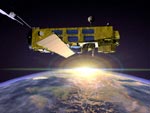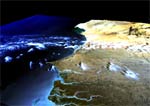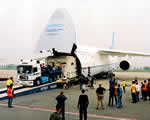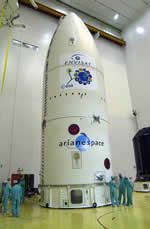Envisat Earth Observation Satellite Kourou, EuropeEnvisat is an advanced polar-orbiting Earth observation satellite which will provide measurements of the atmosphere, ocean, land and ice over a five year period and was launched in March 2002 on an Ariane 5 rocket by the European Space Agency (ESA). The Polar Platform (PPF) has two elements: the service module (SM), and the Payload module (PLM). The SM houses the main satellite support functions, such as command and control, communications with the ground, power, attitude and orbit control, and propulsion. The PLM houses Envisat instruments and PPF payload support equipment (data management and communications, electrical distribution). The instruments aboard the PLM include: Michelson Interferometer for Passive Atmospheric Sounding (MIPAS); Global Ozone Monitoring by Occultation of Stars (GOMOS); Scanning Imaging Absorption Spectrometer for Atmospheric Cartography (SCIAMACHY); Medium Resolution Imaging Spectrometer (MERIS); Advanced Along Track Scanning Radiometer (AATSR); Advanced Synthetic Aperture Radar (ASAR); Radar Altimeter 2 (RA-2); Microwave Radiometer (MWR); Doppler Orbitography and Radiopositioning Integrated by Satellite (DORIS); Laser Retro-Reflector (LRR). The Envisat data will support Earth science research and allow monitoring of the evolution of environmental and climatic changes. It will also facilitate the development of operational and commercial applications. ENVISAT POLAR PLATFORMThe Envisat polar platform is configured to maximise the space available for instruments. The instruments consist of: two radar instruments, three spectrometers of different types and measurement characteristics, two different radiometers (broad and narrow band), the first high-resolution spaceborne interferometer for long-term observation and two instruments for range measurements. ENVISAT TESTINGThe Envisat satellite went through its last testing in January 2001. The tests were conducted at the ESA Test Centre in Noordwijk, the Netherlands, before the satellite was shipped to Kourou for launch. For transport, Envisat was put into two large containers: a Payload Module container and a Service Module container. Getting all the equipment out to the French dependency was a major task involving the transport of machinery by air, land and water. The launch had originally been intended for July 2001, but this date was thrown back after problems were discovered in the upper stage of the rocket. The ignition of the rocket's Aestus engine was unsatisfactory. The satellite was finally launched in March 2002. ENVISAT GROUND OPERATIONSThe ground segment has two major elements. The flight operation segment has command and control of the satellite. The payload data segment is responsible for instrument data. The ground stations are at Kiruna, Fucino, Svallbard, and Villafranca. The last is responsible for TT&C back-up. When the satellite is not visible, the ground stations will receive data through the ESA data relay satellite system Artemis. The flight operations control centre (FOCC) is located at ESOC in Darmstadt, Germany. ENVISAT CONSTRUCTIONThe development and construction of the spacecraft has taken more than ten years, with the involvement of almost 100 companies in 14 countries. Astrium UK was the prime contractor to ESA for two of the major instruments and the Polar Platform. Astrium Germany was Mission Prime to ESA with overall responsibility for the instruments, the Payload Equipment Bay and two instruments specifically. Astrium (France) had responsibility for the Service Module and other instruments. Envisat also has a number of other companies involved in the construction. Thomson-CSF Services & Systemes Sol Spatiaux is prime contractor responsible for overall programme management, central procurement of hardware and software, system engineering, and system validation and acceptance for the payload data segment. The PPF construction is led by Matra Marconi Space in Bristol, United Kingdom, which is also responsible for the final satellite integration and preparation for launch. Dornier Satellitensysteme GmbH, Germany has major development responsibility for Payload Equipment Bay, which is part of the Payload Module, and Matra Marconi Space in Toulouse, France, is leading the Service Module development.
|
 Envisat is an advanced polar-orbiting Earth observation satellite that was launched in March 2002 on an Ariane 5 rocket by the European Space Agency (ESA). | |
 Envisat at that time was the largest European satellite ever to be launched. | ||
 The Envisat satellite went through its last testing in January 2001 before being shipped to the French dependency Kourou for launch. Transportation was a major task involving the transport of machinery by air, land and water. | ||
 The flight operation ground centre has command and control of the satellite. The ground stations are at Kiruna, Fucino, Svallbard, and Villafranca. The flight operations control centre (FOCC) is located at ESOC in Darmstadt, Germany. | ||
 Loading the Payload Module on to Antonow 124 at Schiphol Airport, Amsterdam. | ||
 The Envisat launcher was assembled in Kourou in August 2001. |

